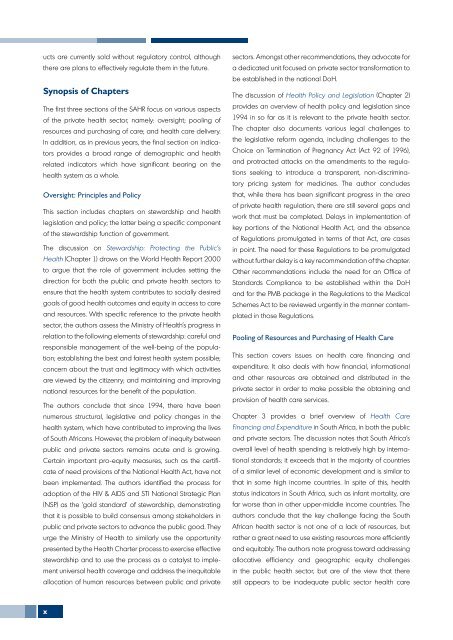SAHR 2007 - Health Systems Trust
SAHR 2007 - Health Systems Trust
SAHR 2007 - Health Systems Trust
You also want an ePaper? Increase the reach of your titles
YUMPU automatically turns print PDFs into web optimized ePapers that Google loves.
ucts are currently sold without regulatory control, although<br />
there are plans to effectively regulate them in the future.<br />
Synopsis of Chapters<br />
The first three sections of the <strong>SAHR</strong> focus on various aspects<br />
of the private health sector, namely: oversight; pooling of<br />
resources and purchasing of care; and health care delivery.<br />
In addition, as in previous years, the final section on indicators<br />
provides a broad range of demographic and health<br />
related indicators which have significant bearing on the<br />
health system as a whole.<br />
Oversight: Principles and Policy<br />
This section includes chapters on stewardship and health<br />
legislation and policy; the latter being a specific component<br />
of the stewardship function of government.<br />
The discussion on Stewardship: Protecting the Public’s<br />
<strong>Health</strong> (Chapter 1) draws on the World <strong>Health</strong> Report 2000<br />
to argue that the role of government includes setting the<br />
direction for both the public and private health sectors to<br />
ensure that the health system contributes to socially desired<br />
goals of good health outcomes and equity in access to care<br />
and resources. With specific reference to the private health<br />
sector, the authors assess the Ministry of <strong>Health</strong>'s progress in<br />
relation to the following elements of stewardship: careful and<br />
responsible management of the well-being of the population;<br />
establishing the best and fairest health system possible;<br />
concern about the trust and legitimacy with which activities<br />
are viewed by the citizenry; and maintaining and improving<br />
national resources for the benefit of the population.<br />
The authors conclude that since 1994, there have been<br />
numerous structural, legislative and policy changes in the<br />
health system, which have contributed to improving the lives<br />
of South Africans. However, the problem of inequity between<br />
public and private sectors remains acute and is growing.<br />
Certain important pro-equity measures, such as the certificate<br />
of need provisions of the National <strong>Health</strong> Act, have not<br />
been implemented. The authors identified the process for<br />
adoption of the HIV & AIDS and STI National Strategic Plan<br />
(NSP) as the ‘gold standard’ of stewardship, demonstrating<br />
that it is possible to build consensus among stakeholders in<br />
public and private sectors to advance the public good. They<br />
urge the Ministry of <strong>Health</strong> to similarly use the opportunity<br />
presented by the <strong>Health</strong> Charter process to exercise effective<br />
stewardship and to use the process as a catalyst to implement<br />
universal health coverage and address the inequitable<br />
allocation of human resources between public and private<br />
sectors. Amongst other recommendations, they advocate for<br />
a dedicated unit focused on private sector transformation to<br />
be established in the national DoH.<br />
The discussion of <strong>Health</strong> Policy and Legislation (Chapter 2)<br />
provides an overview of health policy and legislation since<br />
1994 in so far as it is relevant to the private health sector.<br />
The chapter also documents various legal challenges to<br />
the legislative reform agenda, including challenges to the<br />
Choice on Termination of Pregnancy Act (Act 92 of 1996),<br />
and protracted attacks on the amendments to the regulations<br />
seeking to introduce a transparent, non-discriminatory<br />
pricing system for medicines. The author concludes<br />
that, while there has been significant progress in the area<br />
of private health regulation, there are still several gaps and<br />
work that must be completed. Delays in implementation of<br />
key portions of the National <strong>Health</strong> Act, and the absence<br />
of Regulations promulgated in terms of that Act, are cases<br />
in point. The need for these regulations to be promulgated<br />
without further delay is a key recommendation of the chapter.<br />
Other recommendations include the need for an Office of<br />
Standards Compliance to be established within the DoH<br />
and for the PMB package in the regulations to the Medical<br />
Schemes Act to be reviewed urgently in the manner contemplated<br />
in those regulations.<br />
Pooling of Resources and Purchasing of <strong>Health</strong> Care<br />
This section covers issues on health care financing and<br />
expenditure. It also deals with how financial, informational<br />
and other resources are obtained and distributed in the<br />
private sector in order to make possible the obtaining and<br />
provision of health care services.<br />
Chapter 3 provides a brief overview of <strong>Health</strong> Care<br />
Financing and Expenditure in South Africa, in both the public<br />
and private sectors. The discussion notes that South Africa’s<br />
overall level of health spending is relatively high by international<br />
standards; it exceeds that in the majority of countries<br />
of a similar level of economic development and is similar to<br />
that in some high income countries. In spite of this, health<br />
status indicators in South Africa, such as infant mortality, are<br />
far worse than in other upper-middle income countries. The<br />
authors conclude that the key challenge facing the South<br />
African health sector is not one of a lack of resources, but<br />
rather a great need to use existing resources more efficiently<br />
and equitably. The authors note progress toward addressing<br />
allocative efficiency and geographic equity challenges<br />
in the public health sector, but are of the view that there<br />
still appears to be inadequate public sector health care
















